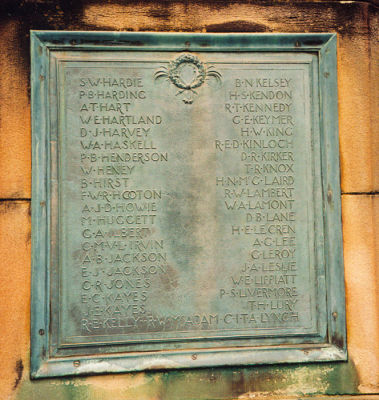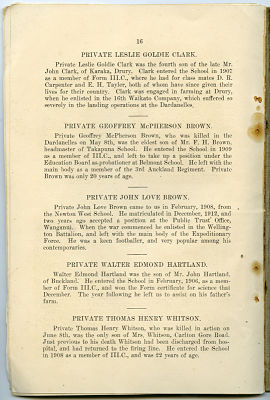WW1 William Edmond Hartland (Service number 12/763)
William Edmond Hartland (Service number 12/763) was born on 6 July 1892 in Buckland, near Pukekohe, Auckland and was the son of John and Annie Hartland.
He attended Auckland Grammar School in 1906 as Walter Edmond Hartland and was awarded the Form III Certificate for Science that year and is mentioned in the Auckland Grammar School chronicle. The following year he left school to assist on his father’s farm. [1]
He was a member of the 16th Waikato Regiment. The Regiment was formed in 1911 as a volunteer infantry regiment in the Auckland Military District as part of the New Zealand territorial forces, known as the ‘Territorials’. Nearly all the initial draft of Waikato recruits were pre-war Territorials. They had frequently attended weekend and annual camps for some years. These first recruits to leave the Waikato were familiar with riding, shooting and camping under canvas. When the call came, they just assembled their units at collection centres. The whole process was very quick, with around 8,500 fully equipped and trained men of the Main Body and close to 4,000 horses leaving New Zealand within six weeks on October 16, 1914. [1]
William enlisted on the 16 August 1914 at Hamilton; he was 5ft 6 ½ inches tall, had brown eyes and brown hair. The Waikato volunteers then entrained to camp in Auckland, many leaving from the old Hamilton railway station. [2] William Edmond Hartland sailed on 16 October 1914 from Wellington and arrived in Suez, Egypt on 3rd December 1914, on the vessel ‘Star of India’ or ‘Waimana’ as a Corporal in the Auckland Infantry Battalion. At his own request he reverted to rank of Private on 26 January 1915. [2]
He was transferred with the New Zealand troops who made the first major effort of World War I during the Allied invasion of the Gallipoli Peninsula in April 1915. The Allies hoped to seize control of the strategic Dardanelles Strait and open the way for their naval forces to attack Constantinople (Istanbul), the capital of Turkey and the Ottoman Empire. Allied forces landed on Gallipoli on 25 April 1915. British (and later French) forces made the main landing at Cape Helles on the southern tip of Gallipoli, while the Australian and New Zealand Army Corps (ANZAC) landed midway up the peninsula. They were sent two kilometres north of their intended landing place, where they encountered determined Ottoman forces in the rugged country above the beach (later known as Anzac Cove). Unable to make any significant advance, the Anzacs spent the next few days desperately holding onto their small beachhead. [3, 4]
William Edmond Hartland was killed in action on 25 April 1915 aged 23. He was awarded the 1914-1915 Star, and the Egyptian Medal 1914 – 1915. William Edmond Hartland is remembered by an obituary in the Auckland Grammar School Chronicle. 1915, on the Auckland Grammar School memorial panel, in the Auckland Domain together with crosses commemorating those who died in World War I and on the wall of the Auckland War Memorial Museum, Hall of memories. He is buried at the Lone Pine Memorial, Lone Pine Cemetery, Anzac, Turkey. [5]

